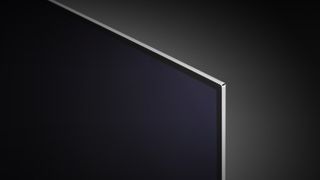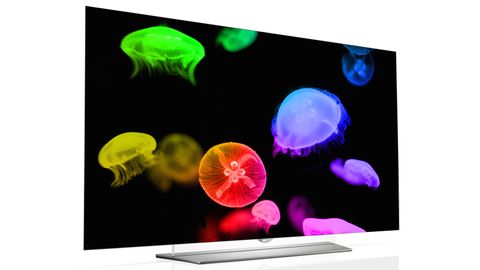TechRadar Verdict
Despite a couple of strange lighting flaws, there are times - lots of them, in fact - where the 65EF9500's pictures look pretty much perfect. The fact that all the 65EF9500's, in some cases unique, attractions are available here in a flat screen at a more affordable price than expected is just the icing on the cake.
Pros
- +
Extraordinary contrast
- +
Gorgeous colours
- +
Sensational design
- +
webOS is brilliant
Cons
- -
Shadowing down the sides
- -
Limited brightness
- -
Contrast can sometimes nosedive
- -
More expensive than LCD
Why you can trust TechRadar
For many serious AV enthusiasts, OLED screen technology is quite simply the future of television.
It's all about OLED's self-emissive pixel design - where every dot in the picture produces its own light level and color independent of its neighbors. It has proved consistently capable of producing levels of contrast miles beyond what's possible with LCD TVs and slightly beyond even the best efforts of its closest technological cousin - Panasonic's much-loved and sorely missed plasma screens.
Two significant problems, though, have stopped OLED TVs from finding their way into AV fans' living rooms in large numbers.
First, issues with manufacturing them in large numbers have meant that their prices have remained stubbornly high - in stark contrast, of course, to the plunging prices of LCD TVs. Second, their shape just hasn't felt right to many, as almost every OLED TV to date has gone for a curved screen rather than a flat one.
Flat is best?
You only have to look at one of LG's sumptuously glamorous curved OLED TVs to understand the attraction in design terms of curving an OLED screen. But for many AV fans issues with curved screens, such as distorted on-screen reflections and geometry issues when viewing from an angle, have made them reluctant to spend big on an OLED screen despite the technology's obvious picture quality potential.
Thankfully LG appears to have been paying attention. For today we're tucking into a new OLED TV that's about as uncurved as it's possible to get.
The OLED TV in question is the 65-inch LG 65EF9500 - and it really and truly couldn't be flatter. In fact, the flawlessly flat finish of its screen is emphasized by the extraordinary lack of depth the TV shows off over much of its rear end. Its large expanse of screen rests on less than 5mm of panel depth for around two-thirds of its rear area, creating a stunning, futuristic look that I'd say is actually more rather than less attractive than LG's curved alternatives.

Making a screen a TV
The reason LG hasn't been able to make the whole of the 65EF9500's rear under five millimetres deep is simply that it has to fit connections, processing systems, tuners and speakers in there somewhere. After all, this is very much a fully formed TV rather than just a 'dumb screen'.
The connections include everything you might reasonably expect of a current high-end TV.
There are four HDMIs for instance, which are built to the latest spec and so can play both native 4K UHD content at up to 60 frames a second while also, crucially, supporting high dynamic range (HDR) playback.
HDR - which can also be played via the 65EF9500's USB ports - is looking set to become the hot new TV ticket for 2016, especially once Ultra HD Blu-rays finally appear.
What it offers is the chance to see video with a greatly expanded luminance range that finally moves past the color and brightness restrictions associated with past TV technologies to deliver much more dynamic, bright, contrast-rich and ultimately more natural images.
Smart features
Where smart features are concerned, the set provides three USB ports for multimedia playback, and also carries built-in Wi-Fi to support both multimedia streaming from networked DLNA-capable devices and access to LG's online services.
These services are pretty rich in content, with the appearance of 4K Ultra HD versions of Netflix and Amazon being particularly welcome.

With so many content options to choose from these days, using your TV can be a complicated business. Fortunately LG tries harder than arguably any other brand to simplify matters with its webOS interface.
webOS
This has been extensively written about elsewhere, so I won't go into detail on it again here. Suffice it to say that its brilliantly responsive, economically presented, effortlessly customizable and thoughtfully constructed on-screen interface does a terrific job of both highlighting stuff you might be interested in and streamlining access to your favorite content sources.
Fittingly for such a high-end TV, LG has equipped the 65EF9500 with a pretty comprehensive suite of calibration tools. These include a good range of color/white balance management options, gamma controls, plus separate OLED Lighting and standard brightness settings.
As mentioned in passing earlier, LG has managed to fit some speakers into the 65EF9500 despite the incredible slimness of its rear (and the fact that its screen frame is less than a centimeter wide, too). In fact, it's worked with the engineers at acclaimed audio brand Harman Kardon to come up with a speaker system that will hopefully deliver a credible audio performance despite the lack of physical space it's got to work with.
One last feature to report before finding out if the 65EF9500 delivers on its flat OLED picture promise is its support for 3D playback. As ever with LG's current TVs it uses the passive system, and ships with free glasses (something not commonly found with rival active shutter 3D TVs these days).
John has been writing about home entertainment technology for more than two decades - an especially impressive feat considering he still claims to only be 35 years old (yeah, right). In that time he’s reviewed hundreds if not thousands of TVs, projectors and speakers, and spent frankly far too long sitting by himself in a dark room.


